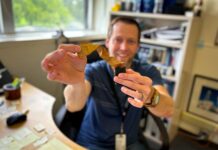
The ability to harness light into an intense beam of monochromatic radiation in a laser has revolutionized the way we live and work for more than fifty years. Among its many applications are ultrafast and high-capacity data communications, manufacturing, surgery, barcode scanners, printers, self-driving technology and spectacular laser light displays. Lasers also find a home in atomic and molecular spectroscopy used in various branches of science as well as for the detection and analysis of a wide range of chemicals and biomolecules.
Lasers can be categorized based on their emission wavelength within the electromagnetic spectrum, of which visible light lasers—such as those in laser pointers—are only one small part. Infrared lasers are used for optical communications through fibers. Ultraviolet lasers are used for eye surgery. And then there are terahertz lasers, which are the subject of investigation at the research group of Sushil Kumar, an associate professor of Electrical and Computer Engineering at Lehigh University.
Terahertz lasers emit radiation that sits between microwaves and infrared light along the electromagnetic spectrum. Their radiation can penetrate common packaging materials such as plastics, fabrics, and cardboard, and are also remarkably effective in optical sensing and analysis of a wide variety of chemicals. These lasers have the potential for use in non-destructive screening and detection of packaged explosives and illicit drugs, evaluation of pharmaceutical compounds, screening for skin cancer and even the study of star and galaxy formation.
Applications such as optical spectroscopy require the laser to emit radiation at a precise wavelength, which is most commonly achieved by implementing a technique known as “distributed-feedback.” Such devices are called single-mode lasers. Requiring single-mode operation is especially important for terahertz lasers since their most important applications will be in terahertz spectroscopy. Terahertz lasers are still in a developmental phase and researchers around the world are trying to improve their performance characteristics to meet the conditions that would make them commercially viable.
Read more: Research team demonstrates terahertz semiconductor laser with record-high output power
thumbnail courtesy of phys.org


















